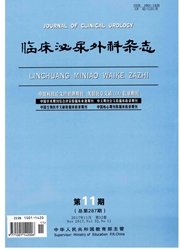

 中文摘要:
中文摘要:
目的:评估输尿管软镜碎石术(RIRS)术后肾下盏残余结石使用体外物理振动排石机治疗的有效性和安全性。方法:采用前瞻性随机对照研究,将所有符合入组标准的尿路结石患者随机分为体外物理振动排石组和自然排石组。体外物理振动排石组在RIRS术后给予物理振动排石机(EPVL)治疗;自然排石组不作处理。两组术后均采用多饮水,增加运动排石。比较两组结石大小、结石清除率、并发症。结果:2015年8月~2016年6月总共有65例患者入组,其中物理振动排石组(试验组)33例(男24例,女9例),自然排石组(对照组)32例(男26例,女6例),试验组和对照组平均年龄为(48.2±1.9)岁和(45.9±2.0)岁,P=0.417;试验组和对照组平均结石直径大小为(15.0±1.0)mm和(13.5±0.7)mm,P=0.237。试验组和对照组RIRS后第2、3和5周结石清除率分别为54.5%vs.21.9%、75.8%vs.46.9%和90.9%vs.56.3%,两组比较差异有统计学意义(P〈0.05)。试验组与对照组比较,RIRS术后第2、5周血尿发生率较低,分别为54.5%vs.81.3%和3.0%vs.25.0%,差异有统计学意义(P〈0.05)。结论:RIRS联合EPVL可以加快RIRS术后肾下盏残余结石的排出和提高结石的清除率。
 英文摘要:
英文摘要:
Objective: To assess the efficacy and safety of External Physical Vibration Lithecbole (EPVL) for the treatment of lower calyx residual stone after retrograde intrarena] surgery (RIRS). Method: A clinical ran- domized controlled trial was designed. All the patients had residual fragments after RIRS for the lower calyx resid- ual stone. They were prospectively randomized into two groups: one received EPVL one week after RIRS, the other only underwent RIRS as a control. Stone size, stone free rate (SFR) and the complications were compared. Result: From August 2015 to June 2016, of 65 cases, there were 33 (24 males and 9 females) in treatment group and 32 (26 males and 6 females) in control group. The median age of patients in treatment and control group were (48.2±1.9) and (45.9±2.0) years old, respectively (P=0.417). The median stone size was (15.0±1.0) mm in treatment group and (13.5±0.7) mm in control group (P=0. 237). SFR in treatment and control group at 2 weeks after RIRS were 54.5% vs. 21.9%, at 3 weeks were 75.8% vs. 46.9% and at 5 week were 90.9% vs. 56.3 %, respectively (all P〈0.05). The hematuria incidence at 2 week after RIRS was 54.5% in treatment group compared to 81.3% in control group (P〈0.05), at 5 week after RIRS was 3.0% vs. 25.0% (P〈0.05). Conclu- sion: EPVL combined with RIRS could accelerate the discharge of lower calyx residual stones and improve SFR.
 同期刊论文项目
同期刊论文项目
 同项目期刊论文
同项目期刊论文
 期刊信息
期刊信息
